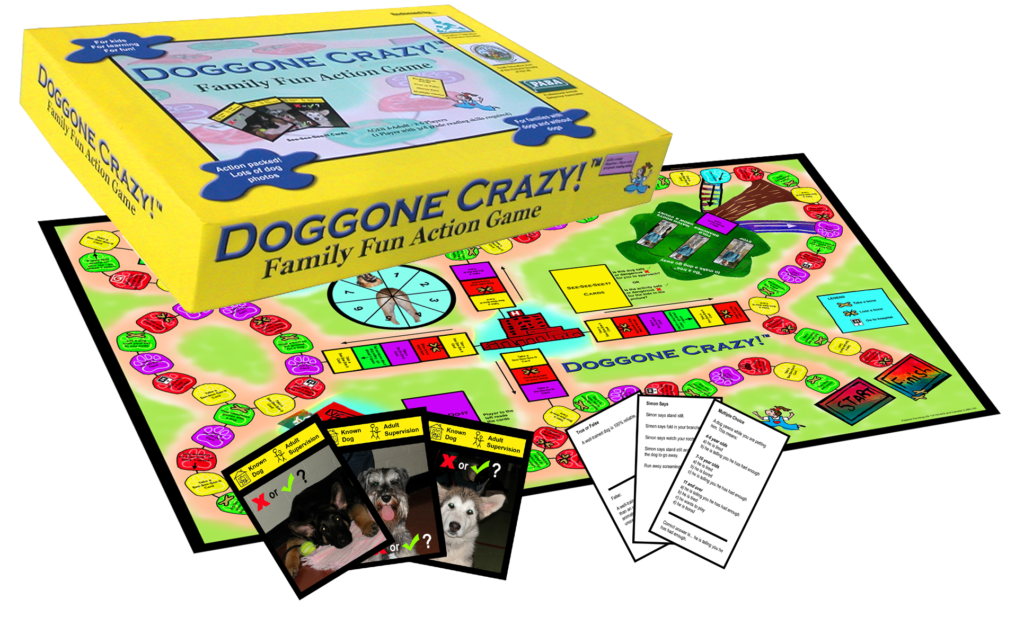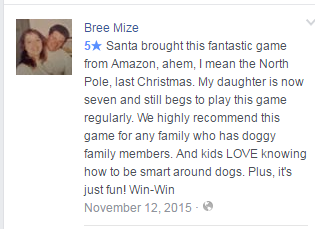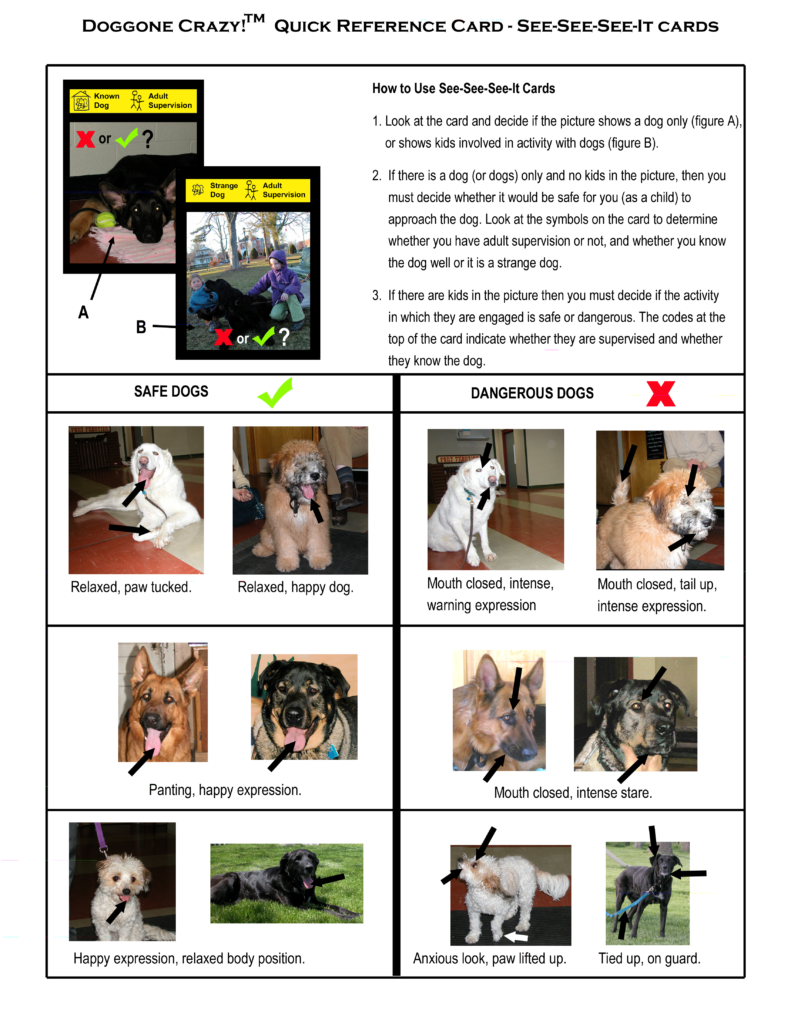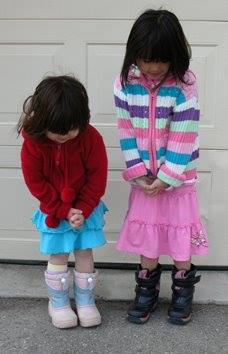Kid tested and expert approved, Doggone Crazy!TM is a family fun board game that teaches kids and adults about the silent language of dogs and how to act safely around dogs. Players race around the board collecting bones. They earn bones by demonstrating safe behaviors, answering questions and interpreting photographs showing pictures of dogs.
This unique and colorful game is fast paced and absorbing even for the most fidgety of youngsters. One player with 3rd grade reading skills required. Takes about 40 minutes to play with 4 players.
See How the Game Works
30 Second Overview
How to Play (4 min video)
Everyone Loves Doggone Crazy!
I love your game! It's the best...my dad, my mom, my sister and I played. We all loved playing your game. It taught me a lot about dogs and how to act around them.
Rachel - Age 10
It’s my brother’s favourite game. Whenever people come up to the cottage the first thing he does is get out the Doggone Crazy! and makes everyone play it.
Kate - Age 10
I played your game and it is so cool. I think that all kids should play it to learn about what their dog is thinking.
Ashley and Nicky - Age 9 & 11
My grandchildren have insisted on playing Doggone Crazy! every day since I gave it to them as a birthday present.
Barb Cooper, Grandmother
Doggone Crazy! is the first board game in a long time to keep my kids attention…they played the game so much that I wasn’t allowed to touch the game for review until the week-end was over.
Alyice Edrich, The Dabbling Mum - National Parenting Magazine
It was a snarling, tail wagging, howling, yip yapping, tree-mendous time!!!! Watch out for the doggy doodoo 🙁 !!!
Game Testing Family
Doggone Crazy is a fun game that teaches children how to interpret the body language and expressions of dogs. I gave the game to my grandchildren and they enjoyed it immensely. The oldest taught the dog signals and appropriate responses to her younger brothers and then proceeded to 'instruct' her parents as well. I think that this is a wonderful contribution toward understanding dogs better and keeping kids safer.
Stanley Coren, Author of "The Intelligence of Dogs", "How to Speak Dog" and "How Dogs Think
Doggone Crazy! is a great game and an important tool for dog bite prevention education. I will support it any way I can.
Dr. Clayton MacKay - Veterinarian - Former president of the Ontario Veterinary Medical Association; Former president of the College of Veterinarians of Ontario; Former president of the American Animal Hospital Association
The described and/or pictured dog postures, movement patterns and specific situations do an excellent job of teaching the child what to look for, what to avoid, and most importantly how to defuse a possibly dangerous situation. I recommend it highly without reservation.
Dr. Ed Bailey, B.S., M.S., Ph.D., Professor Emeritus, Animal Behavior University of Guelph
Does Standing Like a Tree Really Work?
I was walking with 7 children when two dogs threatened us. We all did a tree and the dogs sniffed and went away. I was so glad I knew about the tree. It works every time!
Linda Locke, Mother – Mississauga ON
The kids were thrilled to come and tell me that they did a tree on the beach and made a strange dog go away.
Cathy Vanderheyden, Mother – Atlanta GA
One of my clients credits your lesson in standing like a tree for saving her young child from a mauling when 2 aggressive dogs escaped from next door and circled the child, barking and growling.
Kerry Vinson, Canine Behavior Consultant - Ontario Canada
Some Amazon Reviews
This game is great for children and adults alike. If children are playing without an adult, one of the children must be able to read at a third grade level. The price for this on Amazon is the best I have seen--even with the shipping charge.
Thinking of getting a dog? This would be an excellent introduction to dog language and could make it easier to teach your new dog. I have used Doggone Crazy to teach dog language to adults in my puppy parenting classes. Vet techs have learned from this game. This would be a fabulous birthday gift for a dog-crazy child.
For thousands of years dogs and humans have lived together. You would think by now humans would have picked up a bit of dog language. Nope, we remain stunningly ignorant of the most basic things dogs try to tell us. Dog language is far richer than tail wagging or not wagging. This game is practically a Berlitz course in dog language.
Parents, grandparents, aunts and uncles--play this game with your children and the knowledge you gain while having fun will help keep you and your children safer around dogs. Dog trainers--this is a great opportunity to introduce clients to dog language in a way that will not overwhelm them.
Think Chutes and Ladders with dog pictures. Add age appropriate quizzes about dog body language along the way and you've got the idea. Kids and their parents learn how to tell if a dog should be approached or not and why. The players practice what to do if they encounter a loose dog. Players collect "bonus bones" for correct answers, the most bones will win. You will win too when you and your children know how to approach the calm dogs and avoid the problem dogs.
This game is a fantastic learning tool to teach children and their parents about understanding and recognising dog body language. The game is not only educational but lots of fun and my two children love it. They have brought it into School and their friends and fellow pupils have really enjoyed playing the game. The game has been well researched and put together. It is my view that this game will assist with keeping kids safe around dogs as they will become more knowledgeable about dog body language. It teaches them when to pet a dog and when not to based on the dogs body language and also where to touch a dog. I would highly recommend this game to all kids and adults.
The kids opened the package when they came home from summer camp yesterday. It was in perfect condition. They loved it! They immediately played a game before they would even consider starting to unpack their suitcases. Then they spent most of the evening telling me all about what to do when an aggressive dog approaches (something about a tree) and about what Fiji is thinking at that moment based on her expressions. Good stuff.
I have to tell you that your Dog Gone Crazy game was one of the highlights of our holidays. The girls opened a couple of things on Christmas Eve and one of them was a joint gift of Dog Gone Crazy. We played that night with their grandmother, which was a perfect inclusive and involving game to play, during that anxious evening before the big day. Since being back in Toronto, the kids have played many times and we have played as a family. We are a family who loves to play games. So, we may not have been a big part of your holidays, but you have been a big part of ours!
My son LOVED to play this as a child. The day after we played for the first time he had a run in with a not-as-friendly-as-one-may-have-previously-thought dog and he knew exactly what to do! This is the perfect game to play before taking your kids to visit friends who have a dog - better still, bring it as a house guest gift!
Independent Media Reviews
Canada Toy Testing Council - 2004 Toy Report
Doggone it, there sure is a lot to learn about dogs! This game facilitates learning through play. Children act like dogs or identify dangerous behaviours of dogs through pictures in this interactive board game. Correct actions and answers are rewarded with bones and the player with the most bones at the end wins. Dog lovers are sure to enjoy this game for two to six players which takes approximately 40 minutes to play. NOTE: Children should never approach a dog without asking the owners permission first.
The Dabbling Mum
Doggone Crazy is the first board game in a long time to keep my kids attention. As soon as the game arrived, they ripped open the package and sat down to play with two visiting friends. The oldest, a 14-year-old boy felt parts of the game were too easy and childish, but that didn't stop him from playing three more rounds! My 13-year-old son, 9-year-old daughter, and her 12 year-old friend laughed, giggled, screamed, and jumped up from their seats (apparently it's part of the game) as they played this game again, and again, and again. In fact, they played the game so much that I wasn't allowed to touch the game for review until the week-end was over.
Doggone Crazy is the perfect board game to help parents prepare their children to be around dogs. Whether you're visiting a friend with a dog, heading down to your local park where others walk dogs, or are thinking about purchasing a puppy for your child, you'll want to get Doggone Crazy. This is an extremely educational game, but it was designed to help your child have fun while learning important key elements, such as when NOT to go near a dog, when to ask for the help of an adult, and when a dog appears to be safe
Myk's Picks - Children's Products
Doggone Crazy was a fun game. I liked learning about dogs. My brother loves animals so it was really fun being able to play a game he actually liked. This game is a good game because it teaches us to be safe around dogs. There was some stuff I didn't know and now I know I will be safe. MyKaela (9 year old expert children's product reviewer).
MyKaela's mom says that MyKaela couldn't help but tell all her friends about her new board game and what she learned.
Frequently Asked Questions
What age is the game aimed at?
It's best for ages 6-11, but younger kids love it too. One person with 3rd grade reading skills is required to read the question cards.
How long does take to play?
It takes about 40 minutes with 4 players. You can play with 2-6 players.
What are the main messages kids will learn from playing the game?
Who created the Doggie Crazy game and has it undergone peer review?
The Doggone Crazy game was created by Joan Orr and Teresa Lewin, internationally recognized experts in humane education and dog training. Game prototypes were sent for testing to many experts including professional animal behavior specialists, veterinary behaviorists, general practice veterinarians, dog trainers, elementary school teachers, early childhood education specialists, humane educators, humane society professionals, social workers and mental health professionals.
Why do you use only photos of real dogs and no cartoons?
Studies have shown that kids learn better from realism than from cartoon drawings. There are lots of other subtle body language signs that we could teach about, but these are not necessary for kids to learn to speak dog. Experienced teachers know that keeping it simple and including lots of repetition and opportunity for practice is the best way to teach.
Panting can be a sign of stress in a dog - why do you tell children that panting dogs are happy?
A panting dog is dealing with the stress by panting. A stressed dog that is not panting is much more dangerous because it has no mechanism to relieve the stress and is therefore more likely to react. Not all stress is bad stress. The dog might be waiting for a child to come and say hello. The waiting and wondering causes mild stress and the dog starts to pant. "Are we going for a walk?", "Are you going to throw that ball?", "Am I getting the cookie?" These are all circumstances that will cause panting due to mild stress and anticipation. We are trying to keep things simple for children. They obviously cannot be expected to tell the difference between a dog panting under mild stress or a dog panting with rapid frantic breaths that indicates extreme stress (still a dog less likely to bite than a highly stressed dog that is not able to pant).
Other things that the children learn during the program should prevent them from interacting with a dog panting out of extreme stress. They are taught to stand sideways and allow the dog to come to them and sniff their fist. A very nervous dog is apt to move away and not come forward to sniff - so they would leave that dog alone. They may also see the half moon eye or the fore paw lift and realize that the dog is anxious. They are taught that if the dog stops panting when they approach it, that the dog does not want to meet them. Hopefully, handlers whose dog are very anxious will say no, when a child asks to pet the dog.
So for the most part a panting dog is a dog waiting with happy anticipation for something good to happen, or at least is a dog that is dealing with its stress. The panting/not panting differentiation is simple for children and immediately rules out many dogs that they may otherwise have wanted to pet and gives them a way to decide whether their own dog (who is the one most likely to bite them anyway) is open to interaction with them. We also teach that children should ask the dog handler to tell the dog to sit before they meet it. The cue "sit" is a stress reliever for most dogs because it is familiar and generally has a positive association and gives the dog some control of the situation. A dog that does not sit for the handler is not under sufficient control for a child to pet. An extremely anxious dog is unlikely to follow instructions and is ruled out on that basis, whether panting or not.
Why do you tell children to fold their hands and look at their feet in the tree position?
Folding their hands gives the children something to do with them and makes them less likely to put their hands up. Some dog bite prevention programs advise putting hands in pockets and backing away (child could trip), or folding hands across the chest. Bringing hands up towards the face like this brings the attention of the dog up towards the face. Keeping hands low keeps dog's head low. Here is a series of photos that illustrates this. The movement of the hands upward attracts the dog to move closer and investigate the hands. The dog's head tends to follow the hands. A smaller dog might even jump to check out the hands. This puts the dogs teeth closer to the throat and face.
We have tested many tree configurations with kids and friendly dogs and overly excited puppies and the less movement the better.
We suggest that children watch their roots grow (look at their feet). This gives them something to look at other than the dog. It gives them a positive image to focus on (roots growing). We also tell them to count in their head to the highest number they know, over and over until help comes or the dog goes away. This gives them something to do with their minds while they are frightened. We have tested looking at feet versus looking ahead with groups of adults. Everyone reported that it is easier not to look at the dog while focusing on your own feet. Every person admitted to sneaking a peek at the dog while trying to look ahead, but not if they were looking at their feet. Children respond much better to specific instructions such as "look at your feet". There is no interpretation involved with this and it is easy to remember. "Look ahead" and "look at something in the distance" or "look up to the sky" are too non-specific and require judgment. In a high stress situation, the less judgment a child needs exercise the better.
Someone suggested to us that it is better for the child to look ahead (but not at the dog) so that they will know when the dog is gone. So we tested this also. Even with your head down a person can see at least 40 feet ahead and to the side, certainly far enough to be able to know if the dog is still in the immediate area. Try it yourself.
I was told to try to block the dog with a book or knapsack if attacked. Why is this not in your game?
Some dog bite prevention educators do suggest this. We stress that if the child stands still and quiet the dog will most likely go away eventually and may come close, but is unlikely to attack if they are still. The movement of holding out the knapsack or book may be threatening enough to trigger a bite that would not have otherwise happened.
We have had many stories of the tree working even with a moving and pushy dog. Movement is a major trigger and even trying to block with a knapsack etc may backfire since the kids are moving, probably looking at the dog and acting like victims. Some people suggest that if a dog is coming fast and looks aggressive and there is time, then trying to feed it a book or knapsack may be a good idea. But then what? If they move away at that point the dog will most likely leave the object and chase them. If they stay still then the dog may lose interest in the object and approach them again. So there is not much difference here from just standing still in the first place. What if the dog was not intent on biting, but the child thought it was and the object enraged or excited the dog? A bite could be provoked that would not otherwise have happened. Unfortunately if a dog is really intent on attack there is really nothing a child can do to prevent it. This is a rare situation and most dogs do not want to attack. If the dog is predatory, then standing still is the least interesting thing to the dog. If the dog is aggressive then standing still is the least threatening thing to the dog.
No-one has tested this with children in a real-life situation for ethical and safety reasons. We have seen a mock situation in a video in which a child is holding a knapsack and backing away while the dog jumps and barks at him. In this scene the dog does not back off and in fact appears to be getting more excited. There is no evidence that backing away and holding out the knapsack is discouraging the dog from attacking. In this particular situation the child could trip and fall backwards while walking backwards which would almost certainly trigger an attack.
We like to keep it simple and stick to the stand like a tree message, because it really is the most likely thing that will save the child's life and does not require any decision making in a time of extreme stress.
Your game doesn't talk much about dog bites to the children - why is this?
The Doggone Crazy game is designed to prevent the situations that lead to bites. The game uses mostly positive messages and does not intend to frighten children by talking about dogs that might bite them. The game gives children the tools they need to evaluate what the dog is thinking and decide whether that dog wants to meet them. We prefer to have them thinking in terms of whether the dog wants to meet them, rather than whether the dog is likely to bite them. The program teaches them to interact only with happy receptive dogs in appropriate ways under adult supervision. They learn more about what they should look for and what they should do as opposed to what they should not do.
Why do you recommend that the child scratch the dog on the side of the neck?
Most dogs enjoy a scratch on the side of the neck. This does not involve the child's hand coming over the dog's head and keeps the child's face away from the dog's face.
Some bite prevention programs suggest that the child should pet the dog on its back. We have tested this method (with adults) and have found that this can startle the dog causing it to turn toward the child. With a large dog and a small child this results in face to face interaction. Even if the dog already knows someone is there it most often turns its head toward the source of the touch. Many dogs find a hand on the back to be a threatening gesture and try to move away. Some turn and snap without fully investigating the reason for the pressure on their back.
Does standing like a tree work in a real-life situation? Will children remember to do this?
We have had several reports from parents of children (and even adults) standing like a tree in a real life situation. Yes they remember to do it if they have practised it! They get lots of opportunity to practice while playing the Doggone Crazy game.
When is it safe for the child to leave the Tree position after an encounter with a dog?
When the dog has lost interest and moved away or when help comes and the dog has been secured. If the child is in doubt they should maintain the tree position. If the child moves and the dog resumes interest then the child should stand like a tree again.
Here's a video that shows a dog losing interest and the regaining interest when the child moves. She should stand like a tree until the dog moves away completely and then she should move slowly. If the dog comes back towards her she should stand like a tree again.










